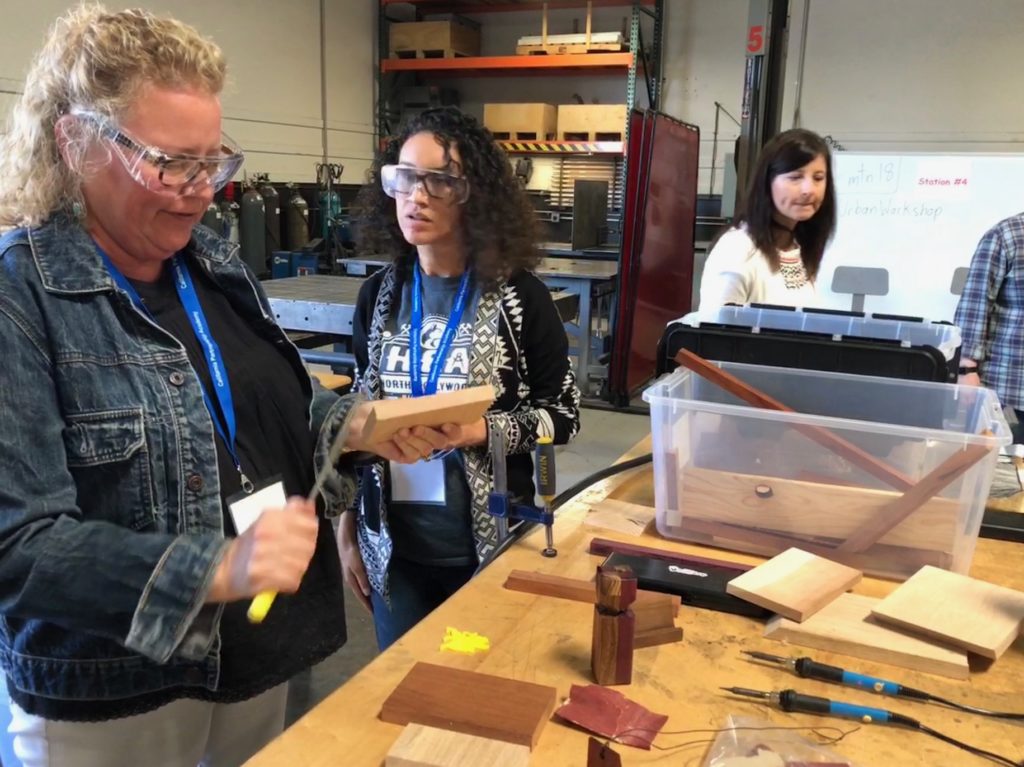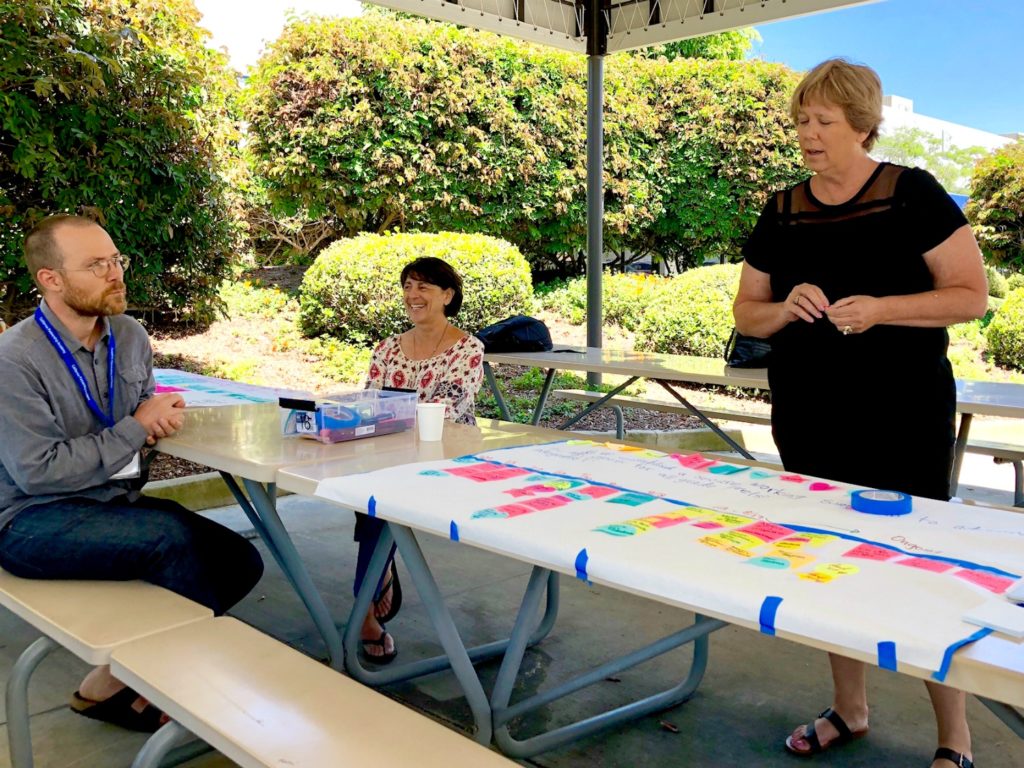In a vast workshop stocked with virtually every tool and raw material imaginable, a team of educators from El Modena High in Orange huddled around scraps of metal, discussing how to make bottle openers.
Not far away, Milissa Roberts, a counselor from North Hollywood High, stood at a woodworking station, fashioning a hall pass to be emblazoned with her team’s spirit animal — a griffin.

Roberts, applying a large file to wood block, considered the task at hand.
“I think it’s kind of empathy-building in the sense that you’re trying something you don’t know how to do,” she said. “It’s about putting people outside of their comfort zone, which I think is where most students are.”
The do-it-yourself design challenge served as a warm-up exercise during last week’s “Moving the Needle Institute,” a multi-day training that brought approximately 120 teachers, counselors and administrators to Urban Workshop in Costa Mesa and the OCDE campus. Their goal? To immerse themselves in the concept of human-centered design thinking, and to carry those lessons back to their schools.
Design thinking is a term derived from the business world, and it’s been defined in different ways. But it generally refers to leveraging human creativity to solve problems with a specific focus on the end-user’s experience. Many believe nurturing this trait is the key to producing workers who can thrive in an era of automation and artificial intelligence.
Schools within schools
Funded by the Laura and John Arnold Foundation, last week’s training was the second of two organized by OCDE in conjunction with the California Department of Education and California Partnership Academies. The latter group is part of a reform movement that breaks high schools into smaller learning communities, but there’s more to it than that.
Campuses that pursue the California Partnership Academy distinction offer schools within schools that combine academics with career preparation. Each academy typically has its own career focus — think health science, digital arts, business or engineering — and many forge business and post-secondary partnerships.
The educators invited to the Moving the Needle Institute came specifically from these academies and participated as teams, according to Jeff Hittenberger, OCDE’s chief academic officer.
“The broad objective is to learn the human-centered design thinking process and apply it in California Partnership Academies so that students can then learn it and apply it to their projects,” Hittenberger said.
To understand how design thinking can be incorporated at the school level, Hittenberger said the group watched a video about a group of Apple Valley High School engineering academy students who designed a wheelchair cover for a classmate with ALS.

“They designed a canopy that could go entirely over his wheelchair, so if it’s raining and he needs to go outside, he would be shielded,” he said. “So ultimately, we’re looking to learn the process to apply these concepts at the student level, which we think is key to navigating the kind of economy that is emerging with the Fourth Industrial Revolution.”
After learning the basics of human-centered design thinking — and tinkering with their own creations at the makerspace at Urban Workshop — teams led by their respective stewards developed plans for improving their academies, deliberating over strategies to integrate curriculum and build industry partnerships. They then gathered feedback from their peers before refining their plans and creating customized roadmaps for implementation.
Jerry Winthrop, the state director of California Partnership Academies, said the institute wasn’t intended to lead participants to specific outcomes. Instead, he said, the goal was to empower academy leaders to work together to find a process that’s right for their schools and clients — meaning students.
“This grant was written in order to enhance the quality of the partnership academies,” Winthrop said. “We have 406 programs statewide. Some of them are better than others, and we wanted to bring up the high tide that raises all boats by looking at new ways of training.”
Empathy and design thinking
Ken Cowan was one of four educators from the Multimedia Careers Academy at Leuzinger High School in Lawndale to attend the training, which began Monday evening and wrapped up on Thursday.

“It was a really productive way of using design thinking methodology to really think about what are the big-picture problems or obstacles that are facing our academy,” he said.
One of the biggest challenges his team faces is student engagement. While some students embrace their work and take ownership of projects, others are more inclined to coast — or even visit YouTube on their classroom computers when they should be working.
Cowan, a CTE teacher at Leuzinger High, said his colleagues devised a plan for staff to connect with students in smaller groups and task them with producing photos, graphic novels, films and perhaps video games that could be showcased at a schoolwide media arts festival. The projects, he said, will be aligned with social issues that are of interest to the students.
“The engagement piece comes because students are already inspired by these issues,” he said.
Simply put, Leuzinger’s Multimedia Careers Academy will employ the lessons of human-centered design thinking by appealing to the interest of students. At the same time, the students will be compelled to consider their end-users as they work creatively on their multimedia projects.
“I think that empathy phase of the design thinking is exactly where you need to start when you tackle a problem,” Cowan said, “whatever your product is.”
